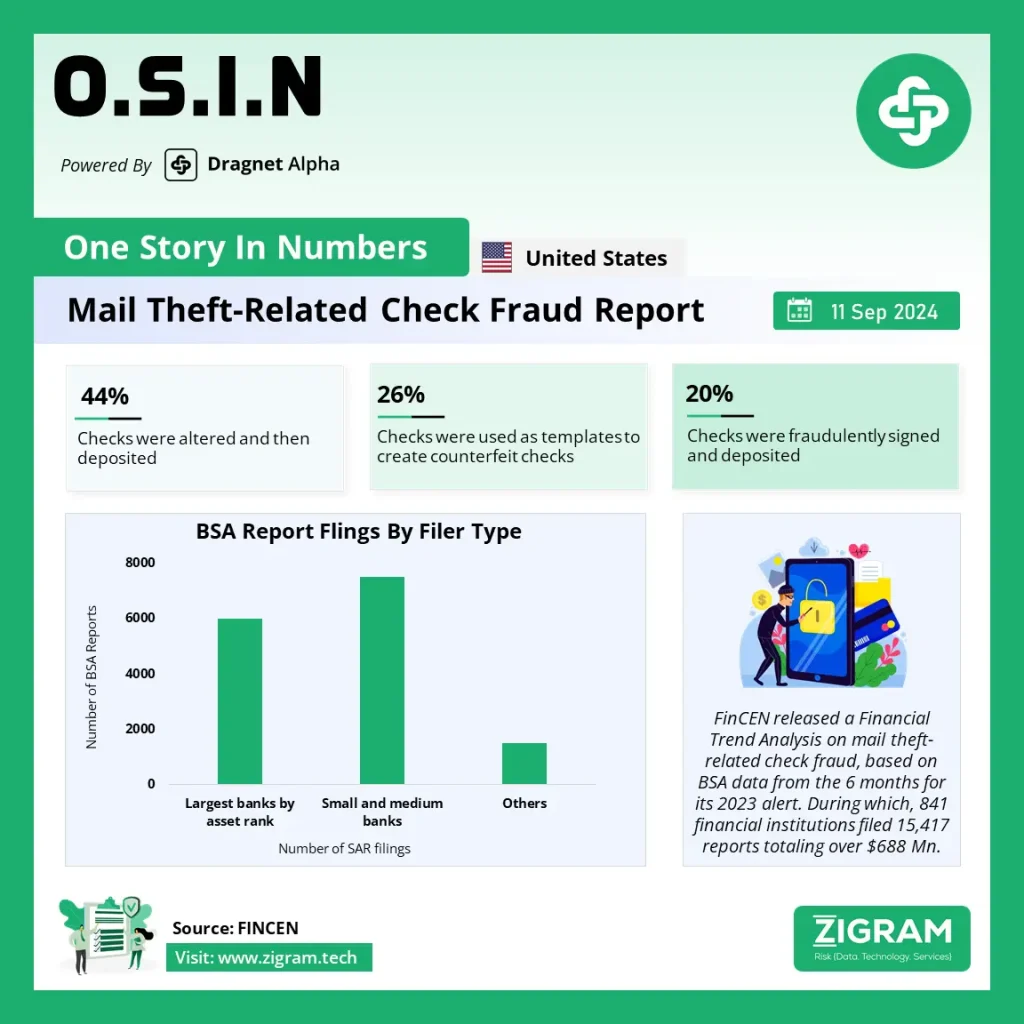On September 09, 2024, the Financial Crimes Enforcement Network (FinCEN) of the U.S. Department of the Treasury released a Financial Trend Analysis (FTA) on mail theft-related check fraud. The analysis is based on Bank Secrecy Act (BSA) data collected in the six months following FinCEN’s 2023 alert on this issue. During this period, FinCEN received 15,417 reports from 841 financial institutions detailing over $688 million in suspicious activity linked to mail theft-related check fraud.
Collaboration With Financial Institutions And Postal Inspectors
FinCEN Director Andrea Gacki emphasized the critical role of financial institutions in addressing this fraud, acknowledging their response to the alert through BSA filings. The U.S. Postal Inspection Service (USPIS) also highlighted the importance of these filings in targeting criminal networks and assisting victims. Chief Postal Inspector Gary R. Barksdale underscored that Suspicious Activity Reports (SAR) are invaluable for identifying perpetrators and supporting restitution for affected individuals.
Findings From BSA Data Analysis
The FTA identified three primary outcomes for checks stolen from U.S. Mail: 44% were altered and deposited, 26% were used as templates for counterfeit checks, and 20% were fraudulently signed and deposited. FinCEN noted that banks accounted for 88% of all mail theft-related check fraud reports, with activity linked to every U.S. state, Washington, D.C., and Puerto Rico. The analysis revealed higher incidences in densely populated states with large urban areas.
Overview Of Key Findings
FinCEN’s analysis identified three primary methods used by criminals after stealing checks from the U.S. Mail: altering and depositing the checks, creating counterfeit checks using the stolen originals as templates, and fraudulently signing and depositing the checks. These methods range from basic to highly sophisticated, often involving advanced counterfeit check technologies and chemical techniques to remove ink from stolen checks.
1. Banks Lead in Filing Fraud Reports: During the review period, banks filed 88% of all reports related to mail theft-related check fraud. The largest banks by assets contributed 44% of these filings, while small to medium-sized banks submitted the majority of Bank Secrecy Act (BSA) reports. According to the data, the most common outcome for stolen checks was alteration and subsequent deposit (44% of cases), followed by the creation of counterfeit checks (26%), and fraudulent signing and deposit (20%).
2. Nationwide Impact and Evasion Techniques: Mail theft-related check fraud was reported in every U.S. state, as well as Washington, D.C., and Puerto Rico, highlighting the nationwide scope of the issue. Many criminals employed methods to avoid direct human contact, such as using remote deposit capture (RDC), automated teller machines (ATMs), and opening accounts online. The sophistication of these frauds varied, with more complex schemes requiring knowledge of advanced technology and chemical processes.
Majority Of Mail Theft-Related Check Fraud Reports
During the first six months after FinCEN’s February 27, 2023 alert on mail theft-related check fraud, financial institutions filed 15,417 Bank Secrecy Act (BSA) reports using the alert’s key term. Of these, banks were responsible for 13,618 filings, representing 88% of the total. The largest U.S. banks, ranked by asset size, filed 44% of all BSA reports submitted by banks. In total, 635 unique banks, including 31 that filed more than 100 reports each, were involved in the reporting process. Reports covered both instances where clients were victims of fraud and cases where clients attempted to deposit stolen or counterfeit checks.
Other Financial Institutions And Reporting Trends
Credit unions and securities/futures firms filed 1,767 BSA reports combined (11.5% of the total). This included 885 filings from 32 securities/futures firms and 882 filings from 165 credit unions. Money services businesses (MSBs) submitted just three reports, as check cashers are not required to file Suspicious Activity Reports, although they may do so voluntarily.
Reported Amounts And Activity Levels
The average reported amount for mail theft-related check fraud was $44,774 per BSA report, with a median amount of $14,215. Some reports included no dollar amounts, while others listed $0 or a nominal amount. Many reports captured the total value of checks even when the transactions did not occur.
Read the full report here.
Please read about our product: Dragnet Alpha
Click here to book a free demo
- #MailTheft
- #Fraud
- #Report
- #FinCEN
- #BSA
- #FinancialCrime
